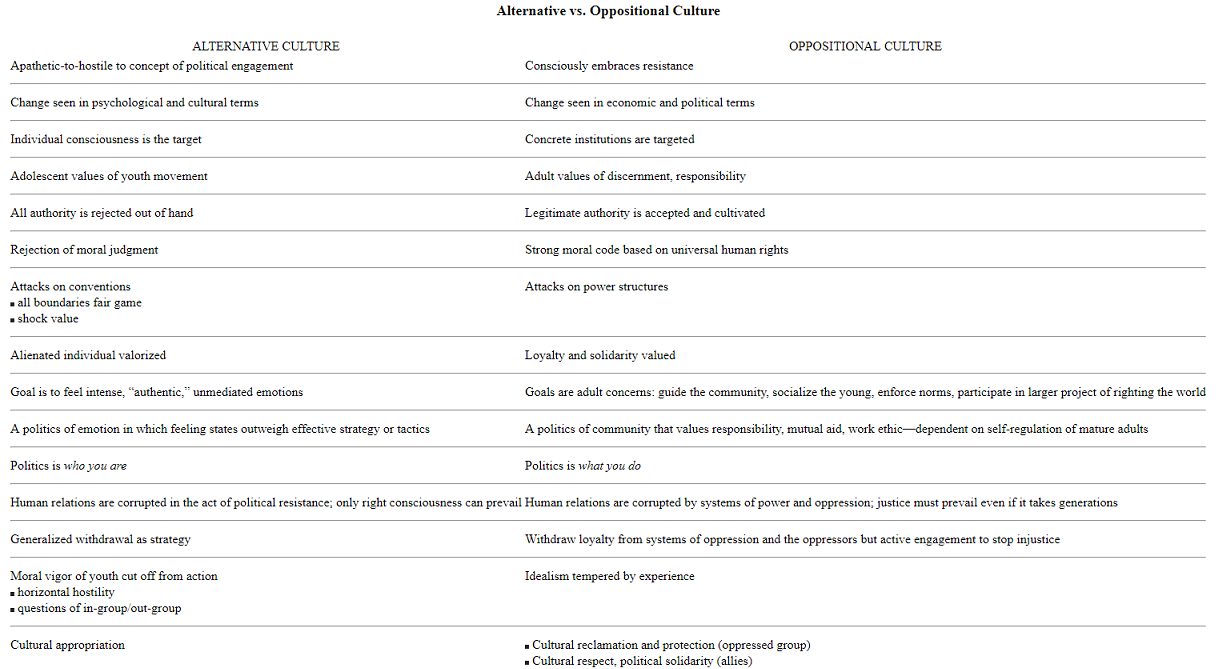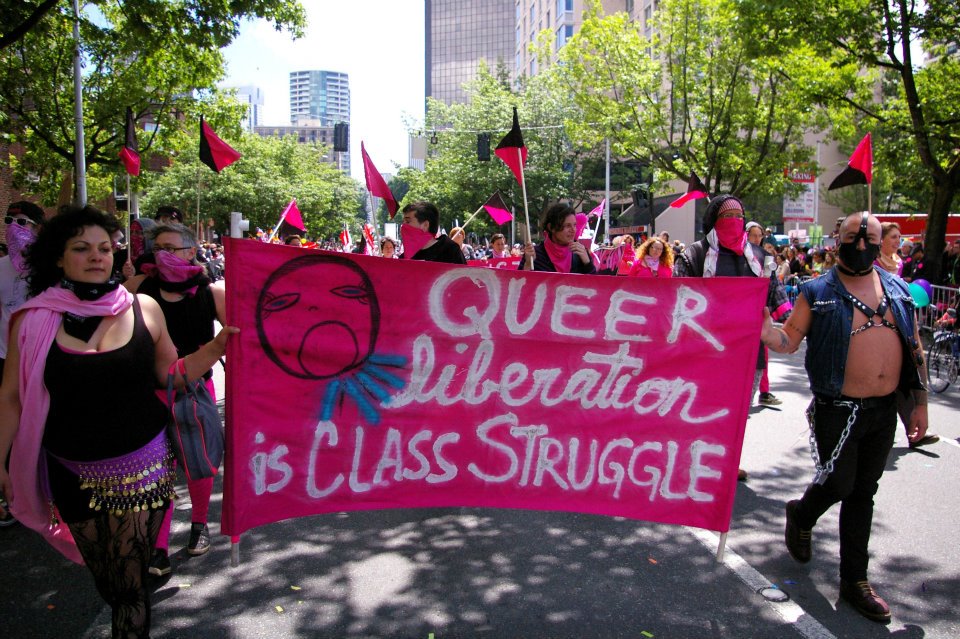
by Deep Green Resistance News Service | Mar 5, 2018 | Culture of Resistance
Featured image: Black Orchid Collective
Editor’s note: The following is from the chapter “Culture of Resistance” of the book Deep Green Resistance: A Strategy to Save the Planet. This book is now available for free online.
by Lierre Keith / Deep Green Resistance
This is the history woven through the contemporary alternative culture. It takes strands of the Romantics, the Wandervogel, and the Lebensreform, winds through the Beatniks and the hippies, and splits into a series of subcultures with different emphases, from self-help and twelve-step believers to New Age spiritual shoppers. There is a set of accumulated ideas and behavioral norms that are barely articulated and yet hold sway across the left. It is my goal here to fully examine these currents so we may collectively decide which are useful and which are detrimental to the culture of resistance.
For the purposes of this discussion, I’ve set “alternative culture” against “oppositional culture,” knowing full well that real life is rarely lived in such stark terms. Many of these norms and behaviors form a continuum along which participants move with relative ease.
In my own experience, these conflicting currents have at times merged into a train wreck of the absurd and the brave, often in the same evening. The righteous vegan dinner of even more righteously shoplifted ingredients, followed by a daring attack on the fence at the military base, which included both spray painting and fervent Wicca-esque chanting—in case our energy really could bring it down—rounded out with a debrief by Talking Stick which became a foray into that happy land where polyamory meets untreated bipolar disorder (medication being a tool of The Man), a group meltdown of such operatic proportions that the neighbors called the police.
Ah, youth.
I was socialized into some of these cultural concepts and practices as a teenager. I know my way around a mosh pit, a womyn’s circle, and a chakra cleansing. I embraced much of the alternative culture for reasons that are understandable. At sixteen, fighting authority felt like life and death survival, and all hierarchy was self-evidently domination. Meanwhile, all around me, in quite varied venues, people said that personal change was political change—or even insisted that it was the only sphere where change was possible. I knew there was something wrong with that, but arguing with the New Age branch led to defeat by spiritual smugness and Gandhian clichés. The fact that I have a degenerative disease was always used as evidence against me by these people. Arguing with the militant, political branch (Did it really matter if someone ate her pizza with “liquid meat,” aka cheese? Was I really a sell-out if I saw my family on Christmas?) led to accusations of a lack of true commitment. With very little cross generational guidance and the absence of a real culture of resistance, I was left accepting some of these arguments despite internal misgivings.
Way too many potential activists, lacking neither courage nor commitment, are lost in the same confusion. It’s in the hope that we are collectively capable of something better that I offer these criticisms.
This focus on individual change is a hallmark of liberalism. It comes in a few different flavors, different enough that their proponents don’t recognize that they are all in the same category. But underneath the surface differences, the commonality of individualism puts all of these subgroups on a continuum. It starts with the virulently antipolitical dwellers in workshop culture; only individuals (i.e., themselves) are a worthy project and only individuals can change. The continuum moves toward more social consciousness to include people who identify oppression as real but still earnestly believe in liberal solutions, mainly education, psychological change, and “personal example.” It ends at the far extreme where personal lifestyle becomes personal purity and identity itself is declared a political act. These people often have a compelling radical analysis of oppression, hard won and fiercely defended. This would include such divergent groups as vegans, lesbian separatists, and anarchist rewilders. They would all feel deeply insulted to be called liberals. But if the only solutions proposed encompass nothing larger than personal action—and indeed political resistance is rejected as “participation” in an oppressive system—then the program is ultimately liberal, and doomed to fail, despite the clarity of the analysis and the dedication of its adherents.
The defining characteristic of an oppositional culture, on the other hand, is that it consciously claims to be the cradle of resistance. Where the alternative culture exists to create personal change, the oppositional culture exists to nurture a serious movement for political transformation of the institutions that control society. It understands that concrete systems of power have to be dismantled, and that such a project will require tremendous courage, commitment, risk, and potential loss of life. In the words of Andrea Dworkin,
Now, when I talk about a resistance, I am talking about an organized political resistance. I’m not just talking about something that comes and something that goes. I’m not talking about a feeling. I’m not talking about having in your heart the way things should be and going through a regular day having good, decent, wonderful ideas in your heart. I’m talking about when you put your body and your mind on the line and commit yourself to years of struggle in order to change the society in which you live. This does not mean just changing the men whom you know so that their manners will get better—although that wouldn’t be bad either.… But that’s not what a political resistance is. A political resistance goes on day and night, under cover and over ground, where people can see it and where people can’t. It is passed from generation to generation. It is taught. It is encouraged. It is celebrated. It is smart. It is savvy. It is committed. And someday it will win. It will win.27
As you can see there is a split to the root between the Romantics and the resistance, a split that’s been present for centuries. They both start with a rejection of some part of the established social order, but they identify their enemy differently, and from that difference they head in opposite directions. Again, this difference often forms a continuum in many people’s lived experience, as they move from yoga class to the food co-op to a meeting about shutting down the local nuclear power plant. But we need to understand the differences between the two poles of the continuum, even if the middle is often murky. Those differences have been obscured by two victories of liberalism: the conflation of personal change with political change, and the broad rejection of real resistance. But a merely alternative culture is not a culture of resistance, and we need clarity about how they are different.
For the alternative culture—the inheritors of the Romantic movement—the enemy is a constraining set of values and conventions, usually cast as bourgeois. Their solution is to “create an alternative world within Western society” based on “exaggerated individualism.”28 The Bohemians, for instance, were direct descendants of the Romantic movement. The Bohemian ethos has been defined by “transgression, excess, sexual outrage, eccentric behavior, outrageous appearance, nostalgia and poverty.”29 They emphasized the artist as rebel, a concept that would have been incomprehensible in the premodern era when both artists and artisans had an accepted place in the social hierarchy. The industrial age upset that order, and the displaced artist was recast as a rebel. But this rebellion was organized around an internal feeling state. Stephen Spender wrote in his appropriately titled memoir World Within World, “I pitied the unemployed, deplored social injustice, wished for peace, and held socialist views. These views were emotional.”30 Elizabeth Wilson correctly names Bohemia as “a retreat from politics.”31 She writes, “In 1838, Delphine de Girardin commented on the way in which the best-known writers and artists were free to spend their time at balls and dances because they had taken up a stance of ‘internal migration.’ They had turned their back on politics, a strategy similar to the ‘internal exile’ of East European dissidents after 1945.”32
The heroization of the individual, in whatever admixture of suffering and alienation, forms the basis of the Romantic hostility to the political sphere. The other two tendencies follow in different trajectories from that individualism. First is a valuing of emotional intensity that rejects self-reflection, rationality, and investigation. For instance, Rosseau wrote, “For us, to exist is to feel; and our sensibility is incontestably more important than reason.”33 Second is a belief that the polis, the political life of society, is yet another stultifying system for the romantic hero to reject:
Romantics … rejected the possibility of effecting change through politics. The Romantics were skeptical about merely organizational reform, about the effects of simply rearranging a society’s institutions.… The Romantics revolted not in the name of equality or to effect economic change but to enable the development of the ‘inner man.’ In this sense, they were opposed to the bourgeoisie and the radicals. Bourgeois conventions were rejected because they were shallow and artificial, and the radical’s program of social and economic change was rejected because it did nothing to free the human spirit.34
The Beatniks were inheritors of this tradition. Their main project was to “reject … the conformity and materialism of the middle class,” mostly through experimentation with drugs and sex, and to lay claim to both emotion and art as unmediated and transcendent.35 But the Beatniks were a small social phenomenon. They didn’t blossom into the hippies until the demographics of both the baby boom and the middle class provided the necessary alienated youth in the 1960s.
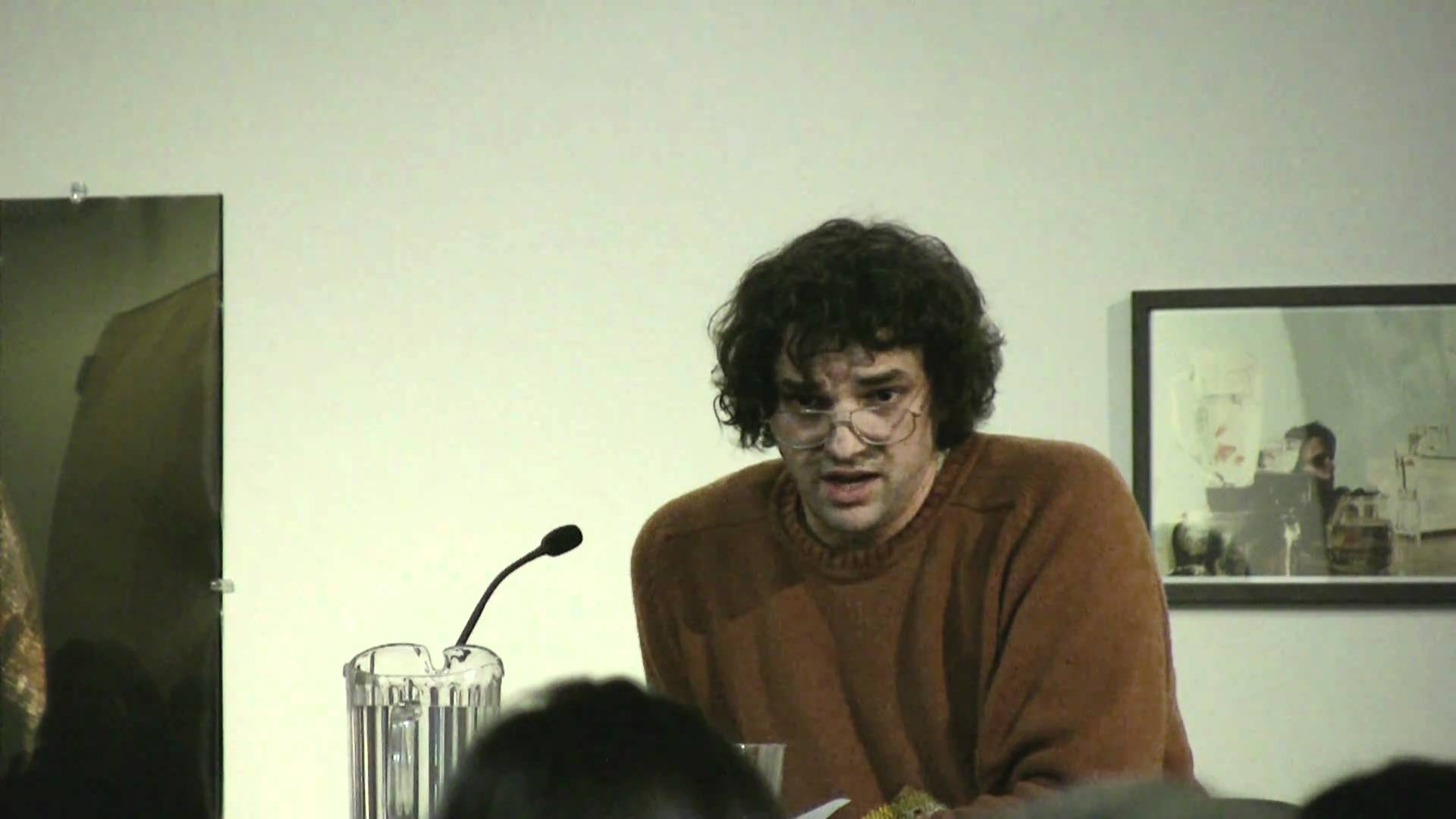
by Deep Green Resistance News Service | Mar 3, 2018 | Culture of Resistance
Derrick Jensen will be speaking at the Eugene Public Library on Sunday, March 4, from 10:30 am to 12:30 pm. The talk is about the destruction of the planet, men’s violence against women, and the male violation imperative at the core of patriarchy.
Originally, Derrick was supposed to be the featured speaker at a reception hosted by the Western Environmental Law Center (WELC) during PIELC (Public Interest Environmental Law Conference). WELC received a single complaint from someone who threatened to gather a group of people to disrupt the event and the organization. In response to this single complaint, WELC deplatformed Derrick.
Some of us do not give in to threats and bullying. Some of us believe it is more important than ever to talk about what we are going to do to stop the destruction of the planet. Some of us believe it is more important than ever to talk about the patriarchal male violation imperative that is leading to this destruction. Thus this event.
To be clear, Derrick was deplatformed because he stands in solidarity with women. He refuses to believe that females, including those who have been sexually assaulted by males, should be forced–as in against their will–to share their most vulnerable spaces with males. He believes that females have the right to bathe, sleep, gather, and organize free from the presence of males.
For that he was deplatformed.
So if you believe we need to stop the destruction of the planet; if you believe that women have a right to discuss their oppression, their bodies, their reality, and their very existence; if you believe that free and open discourse is foundational to a functioning democracy; if you recognize that the Left has embraced McCarthyite tactics to its profound detriment; and if you refuse to give in to bullies, come to Eugene.
Here is the video of the event: https://www.facebook.com/deepgreenresistance/videos/1741147465944349/
We will continue to fight, no matter how badly our speakers are treated.
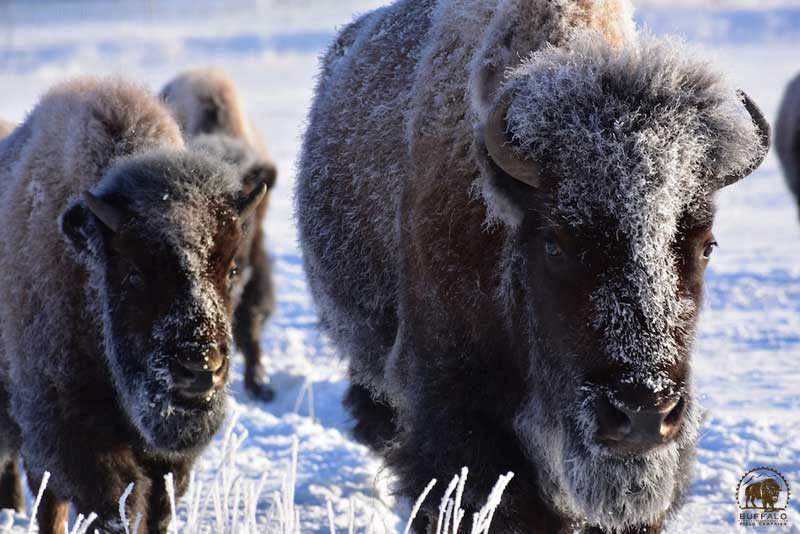
by Deep Green Resistance News Service | Mar 1, 2018 | Biodiversity & Habitat Destruction
Featured image: A single mom with seven calves who she is caring for. More than likely, only one of these calves are hers, and the rest of these babies are buffalo she adopted after their mothers were killed by hunters. BFC photo by Stephany Seay.
by Stephanie Seay / Buffalo Field Campaign
It’s just below zero as we trek through freshly fallen snow on an unusually windless early morning, in the high hills above the Gardiner Basin. Taking advantage of the calm air that won’t rock our scopes and cameras, our patrol is on the way to a lookout spot high above Yellowstone’s Stephens Creek buffalo trap. The trap is miles away. The spot we’re at is one of the few places that we can see even a far-away glimpse into the industrial size monstrosity that has entrapped more than 450 of the gentle giants in the past couple of weeks. Yellowstone initiates a massive seven-mile public closure around their trap, obviously wanting to hide the horrible things they are doing to this sacred species, our national mammal. On our way to the lookout, our footsteps squeaking through the freezing cold snow, one of our crew shouts out, “wolves!” We all stop dead in our tracks. To the south of us, we can hear them, the beautiful, haunting serenade of a wolf pack, singing blessing songs to the morning, or, more like mourning songs to the travesty unfolding before us. The wolves know. We get to the lookout spot and it’s as bad as we thought: hundreds of buffalo in the trap, huddled together, eating hay rations, trapped on death row. Four park wranglers on horseback, and a white SUV are coming into the northernmost paddock of the trap which holds approximately 60 of the country’s last wild buffalo. This paddock is the veritable end of the line before the buffalo go in even deeper, to places they will never return from.
“Genocide,” our Blackfeet brother says. We nod in agreement. The U.S. Government continues the systematic destruction of the sacred buffalo, and for the same reasons, too. Only, these days, instead of Buffalo Bill and Wild Bill Cody, they call it “management” and the killers are the so-called guys in green: Yellowstone National Park. Donning buffalo on their uniform badges, they are the very ones who are obligated to protect the buffalo — the buffalo who are the main reason this park even exists, that people even come here. These “caretakers” are facilitating all of the trapping and most of the killing. As we watch through our scopes and binoculars, eyes teary from the blistering cold, or the pain in our hearts, the wranglers go in for the attack. It’s just another day in the park. Frantic, the sixty buffalo run away from the wranglers, but the only path open to them is the dark corridor that leads into the labyrinth of the trap, towards the bull pen and the squeeze chute, towards the end of freedom and family, into the tiny holding pens where they will spend their last hours in feces and fear, before being loaded onto livestock trailers headed for the slaughter house. The mournful howling continues. The wolves know. We join in.
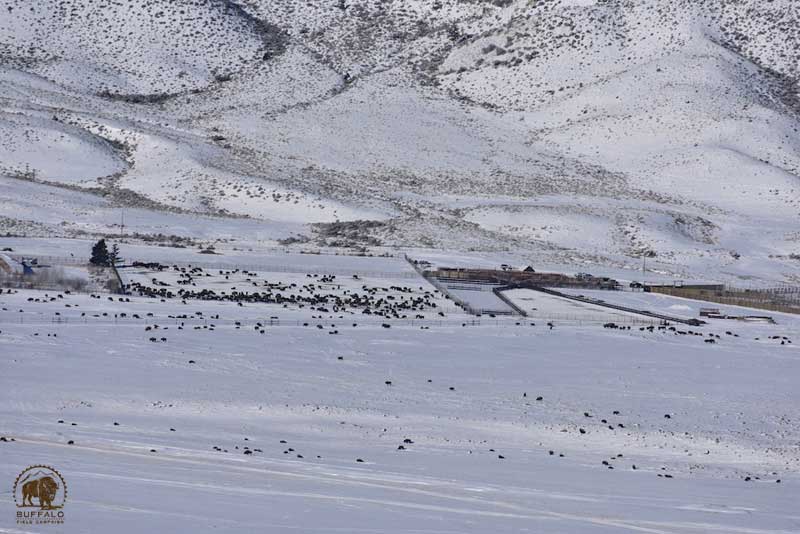
A bird’s-eye view of Yellowstone’s Stephens Creek buffalo trap. The massive closure is an attempt to keep the public from seeing what Yellowstone is doing. BFC photo by Stephany Seay.
Anticipating shipments to slaughter, the next morning we rise even earlier to get our sites on the trap before the trailers arrive. We are well ahead of schedule. Our presence, our vigilance is the only way for anyone to know what is taking place here, for anyone to know what is really happening to the buffalo. Once posted up, we send one patrol high into the hills for an even better birds-eye view. Even so, both lookouts rely on the powerful magnification of spotting scopes to see anything, and tiny-dot-anythings at that. With the naked eye, the trap and it’s happenings are hardly visible at all. The trap is so strategically located that Yellowstone’s shame and desire for secrecy are apparent. Just before dawn, multiple vehicles start arriving to the trap. The unmarked rigs of the wranglers, a few park service law enforcement officers, Yellowstone’s bison biologist, Rick Wallen, and others, get ready for another day of wild buffalo abuse. Then the stock trailers show up, flanked by law enforcement escorts. It takes less than an hour for them turn wild buffalo from sacred, free-born beings into “pounds on the hoof” headed for the slaughter house.
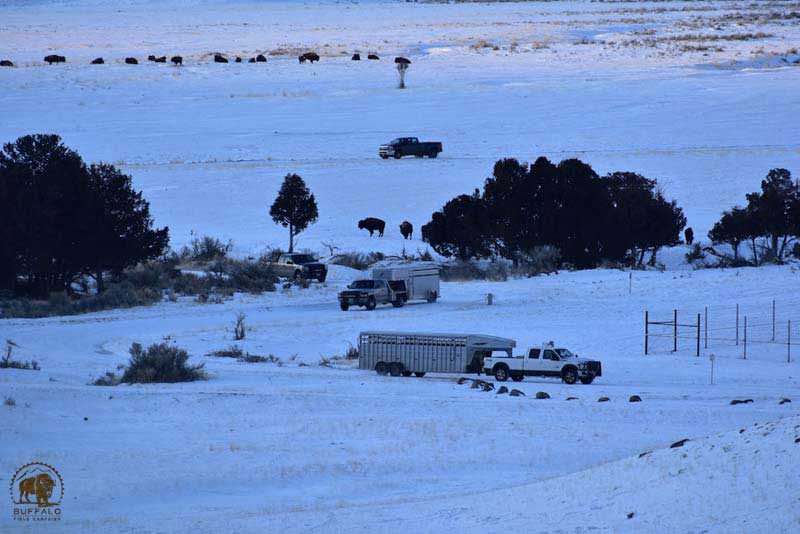
2018 03 01 03 003 Update3 Buffalo Field Campaign Stephany Seay 2018 800 Two stock trailers drive through Yellowstone, and groups of buffalo, taking buffalo who were captured at Yellowstone’s facility to slaughter on Wednesday morning. BFC photo by Stephany Seay.
The dominant culture — not even those who might care — can’t bear to look into the face of the reality of its actions. It views the human supreme; born out of a cold arrogance lusting for control, enabling the conversion of the living into the dead for profit. Forgetfulness, mindlessness – “with guns and laws and truth that lies” – help grease the gears of the machine; numbness is the key to conducting wildlife “management.” It is said that once you see, you cannot unsee. A self-inflicted blindness enables it —to see would break their hearts and force their souls wide open. So, with brutal efficiency, the government workers keep their blinders on, do their jobs, and hold fast to the agreed upon Interagency Bison Management Plan.
Approximately 450 wild buffalo have been captured in Yellowstone’s trap, and nearly 250 have been killed by hunters just across Yellowstone’s boundary. By Yellowstone and Montana’s own standards, the middle-end of their 600-900 kill quota — in place to appease Montana’s cattle interests — has already been met. After the last few weeks of extremely unsavory ‘hunting’ along Yellowstone’s north boundary, very few hunters have come to kill buffalo this week. Many have left here utterly disgusted, vowing never to participate in such a slaughter again.
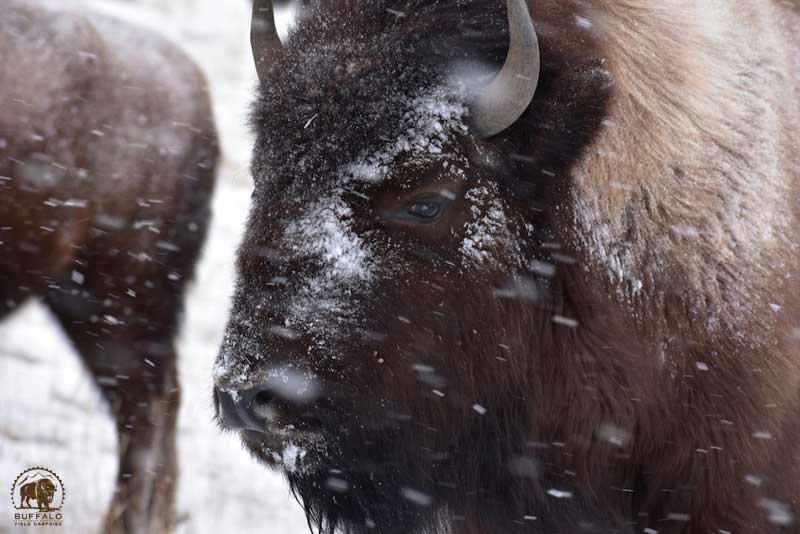
With their enormous, shaggy heads, buffalo face into a storm. We have much to learn from our relatives, the buffalo. BFC photo by Stephany Seay.
Before and after bearing witness to this insanity, we are reminded of the real reason we are here. Other buffalo, who were not in the trap, gave us the gift of remembering and connection, the honor of being in their presence and living in the moment. They help us remember who we are fighting for — and with — and why. The buffalo help us connect with their humbling ancient wisdom; a truth so incredibly sacred because of its gentle simplicity and rightness.
The blizzard came in quick and heavy, and the buffalo moved right along with it as they always do. With their heads into the storm, grazing and walking, sparing and goofing around, they look up at us for moments with the eyes of god, the faces of ghosts, awakening memories of ages past and future potentials. Still here. Still present. Still doing what they have always done since buffalo time began. Where they walk, ravens feast on the gut piles of their recently killed relatives, strewn across the landscape at Beattie Gulch, a beautiful place that has become synonymous with death. And, yet, the buffalo still come, still offer life, staying among the living. Obstacles be damned. These ancient beings have survived Ice Ages; now the question is: can they survive the U.S. government? In the joy of sharing time and place with the buffalo, in our pain and anger fueled by management plans, being in the company of friends both human and buffalo recognizing each other, committing to each other again; in our solidarity among our comrades we understand that all of these things come from love. Profound love. The buffalo and their wildness, their teachings of sorrow and joy, their obligation to the earth, and ours to them. These realities keep awake our spirits, reaffirm and strengthen our vow: yes, you will survive, and we will give ourselves to make sure of it; fighting for you, along side you.
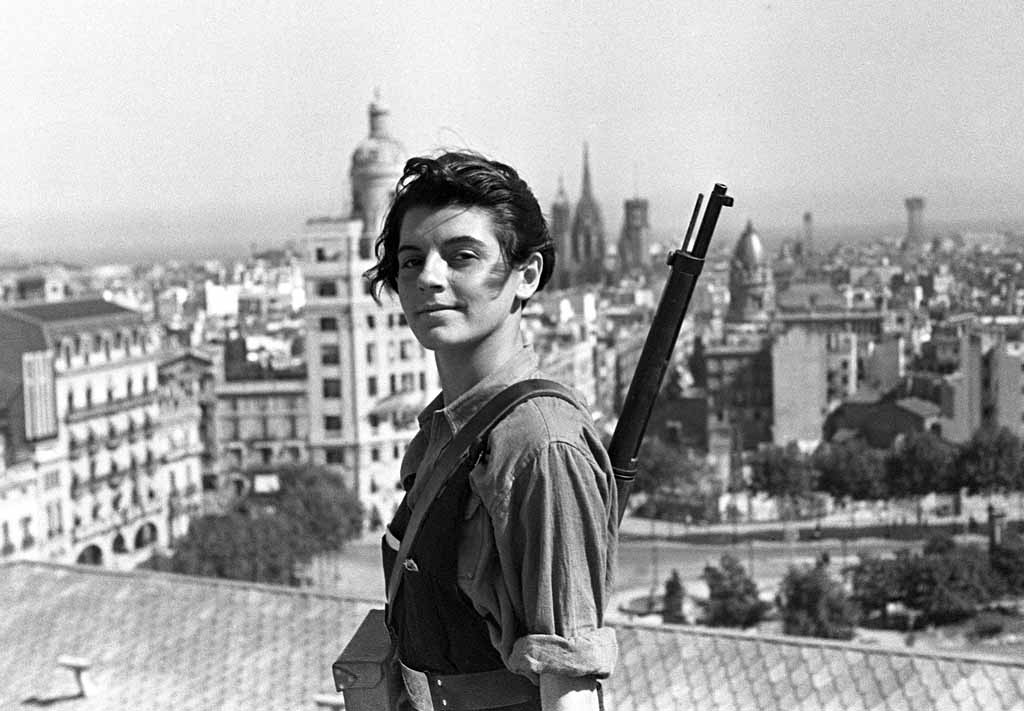
by Deep Green Resistance News Service | Feb 28, 2018 | Culture of Resistance
Featured image: Marina Ginestà i Coloma, 17-year old communist militant, on top of the Hotel Colón in anarchist Barcelona during the Spanish Civil War
Editor’s note: The following is from the chapter “Culture of Resistance” of the book Deep Green Resistance: A Strategy to Save the Planet. This book is now available for free online.
by Lierre Keith / Deep Green Resistance
Past movements for social justice insisted on character in their recruits, in honor, loyalty, and integrity. The culture of resistance created by the Spanish Anarchists valued ethical personal behavior. Writes Murray Bookchin, “They were working men and women, obrera consciente, who abjured smoking and drinking, avoided brothels and the bloody bull ring, purged their talk of ‘foul’ language, and by their probity, dignity, respect for knowledge, and militancy, tried to set a moral example for their entire class.”82 We could do worse. The right will continue to successfully blame the left for the destruction of culture and community as long as the left can’t or won’t stand firmly in defense of our values.
This is probably the right time to defend the concept of a work ethic. The alternative culture of the ’60s was in part a reaction against the conformity of the ’50s and its obedience to authority. In 1959, my mother and her friends decided to start an underground newspaper at their school. Their first step? Asking permission from the principal. He said no. They dropped the idea. No wonder the ’60s happened.
The alternative culture was based on the premise that essentially nobody had to do anything they didn’t feel like doing. A major part of their rebellion was the rejection of a work ethic, always cast as Protestant. But taken to its logical end, this is the position of a parasite. The dropouts either got money from their parents, from friends who got it from parents, or from the state. Eventually, each life has to be supported with resources from somewhere. I have seen a few too many protests and alternative communities surviving on the Mooch Ethic. I have sat on couches that housed rats, eaten off dishes that gave me gastroenteritis, and learned (secondhand, thankfully) that an itchy butt at sundown means pinworms. I’ve watched incredible resources go to waste—houses fall to ruin, land repossessed—for refusal to do basic adult tasks like paying the taxes. I don’t know which is worse: the general ethos’s entitlement, or the stupidity; the smell of the outhouses, the unwashed bodies, or the marijuana.
The rebellion against a work ethic is another characteristic of youth culture. The ventral striatal circuit, which is the seat of motivation in the human brain, doesn’t function well during adolescence, which is why teens are often accused of being lazy. This means that the norms of youth culture will gravitate toward structureless days with no expectations or goals. It also means that the youth culture and marijuana aren’t a good match.
The war on drugs is appalling. It has a corrosive effect on communities of color especially and has also made it difficult for those with legitimate need to get pain relief from drugs like marijuana.83 Medical cannabis is a legitimate treatment for a number of conditions, some of which, like autoimmune disorders, are life-threatening. People who need it should be able to get it, and society as a whole would probably be better off if cannabis was legalized.
But drugs and alcohol have been a terrible detriment to both activist cultures and oppressed communities. I have watched people that I love erode with addiction, a slow death I’m powerless to stop. I am very sympathetic to the straight-edge punks. It was obvious to me at age fourteen that there were two weapons I would need for the fight: a mind that could think and the heart of a warrior. Drugs would destroy the one and numb the other. I swore away from drugs and I’ve never regretted that decision.
Drug and alcohol addiction has had terrible effects on both oppressed communities and cultures of resistance. Such effects are broad and deep: the self-absorption, lack of motivation, and broken synapses create a population in semipermanent “couch lock.” Drugs and alcohol will not help us when we need commitment, hard work, and sacrifice, which are the foundation of all cultures of resistance. Addicts have no place on the front lines of resistance because an addict will always put their addiction first. Always.
I came of age in a post-Stonewall lesbian community that recognized the role that alcohol had played in destroying gay and lesbian lives. Our events specifically avoided bars as venues, and were often labeled “chem-free.” These were and are acts of communal self-care that were linked to survival and resistance. It was an important ethic, and it was understood and embraced. There are parallel calls for a chem-free ethic in some Native American activist groups, and for the same reason: drugs and alcohol have been damaging enough to name them genocidal. The radical left would do well to model itself on these recent examples and to consider an ethic of sobriety as both collective self-care and resistance. We need everyone’s brain. If our goal is a serious movement, then we also need focus, dependability, and commitment. On the front lines, we need to know our comrades are rock solid. In our culture, we need a set of ethics and behavioral norms that can build a functioning community. Basic awareness of addiction—its symptoms, its treatment options—is important both to help the afflicted and to keep our groups safe and strong.
A related issue is the general lassitude caused by poor nutrition exacerbated by vegetarian and vegan diets. One investigator of alternative communities writes, “… for many of the rural groups, common activity is limited to part-time farming. In their permissive climate, there is often a debilitating, low-thyroid do-nothingness that looks like nothing so much as the reverse image of the compulsive busyness of their parents.”84
The diet that holds sway across the left will produce that state exactly. A food ethic stripped of protein and fat may meet ideological needs, but it will not meet the biological needs of the human template. Our neurotransmitters—the brain chemicals that make us happy and calm—are made from amino acids; amino acids are protein. Serotonin, for instance, is produced from the amino acid tryptophan. We cannot produce tryptophan; we can only eat it. Likewise endorphins and catecholamines. We must eat protein to have brains that work. We need fat, too, and you’ll notice that in nature, protein and fat come packaged together. In order for your neurotransmitters to actually transmit, dietary fat is crucial. This is why people on low-fat diets are twice as likely to suffer from depression or die from suicide or violent death. If you need more reason to eat real food, your sex hormones are all made from dietary cholesterol: please eat some. A steady diet of carbohydrates, on the other hand, will produce depressed, anxious, irritable people too exhausted to do much beyond attend to the psychodramas created by their blood sugar swings, which about sums up the emotional ambiance of my youth. And the author’s inclusion of “low-thyroid” in his description is right on the mark. Soy is often the only acceptable protein on the menu. Besides its poor quality—plant protein comes wrapped in cellulose, which humans cannot digest—soy is a known goitrogen. In large enough quantities, like when eaten not as a condiment but as a protein source, it can suppress and even destroy the thyroid.
I’ve been to a few too many potlucks with brown rice, dumpster-dived mangoes, and the ubiquitous chips and hummus. I feel my grandmother’s horror from the grave: why are we feeding each other poverty food? This is the only time I feel sorry for men, watching them repeatedly—and I mean four and five times—approach my pot of (pasture-raised) beef-and-leek chili for more. They’re desperate. They may be getting enough bulk calories every day, but they’re starving. Men tend to crave protein because their protein needs are higher—testosterone means men have more muscle than women, and muscle is built from protein. Women tend to crave fat because our bodies are designed to store fat for pregnancy and lactation.85 The current anorexic beauty standards, besides being a very effective tool of patriarchy and capitalism, also point to a profound death wish embedded in this culture. Humans have been celebrating female fat—a veneration both aesthetic and spiritual—since we created art and religion. Our first two art projects reverenced the lives that made ours possible: the large ruminants we ate and the large women who birthed us.
We must stop hating the animals that we are. Only ideological fanatics (I was the most extreme version—vegan—for almost twenty years, so I’m allowed to say that) will be able to stick to such body-punishing fare for any length of time. Everyone else will “cheat” and feel guilty over moral or even spiritual failings without understanding why they failed. The answer is simple: we have paleolithic bodies, we need paleolithic food. If you’re fighting evolution, you are not going to win. There is a reason you feel hungry without fat and protein, a reason for the exhaustion that aches in your muscles and surrounds you like fog, a reason for the gray weight of depression. A plant-based diet is not adequate for long-term maintenance and repair of the human brain or body, and it has been taking a heavy toll on the left for several generations.
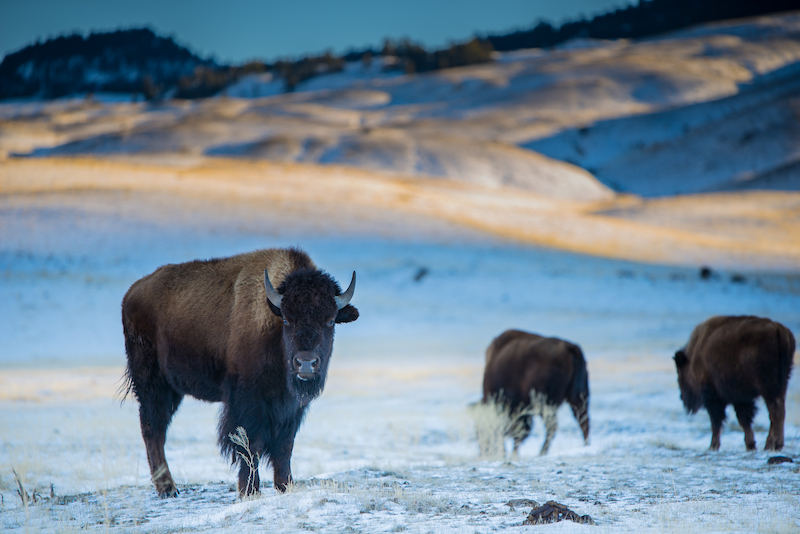
by Deep Green Resistance News Service | Feb 26, 2018 | Biodiversity & Habitat Destruction
by Max Wilbert / Deep Green Resistance
“One person died and another was badly burned when a gas well exploded here last year,” my friend Adam says, pointing to an oil well set back a hundred yards from the road. We’re on the plains beneath the Front Range in Colorado, where the Rockies meet the flatlands. Oil country. Wells and fracking rigs are everywhere, scattered among the rural homes and inside city limits.
I’m on my way home from volunteering with Buffalo Field Campaign outside Yellowstone National Park, and I’ve stopped in Colorado to see friends and learn more about the fight against fracking that’s going on here.
Adam explains to me that there are thousands of wells in the area, despite widespread opposition. Cities have passed laws against fracking, been sued by industry groups in response, and lost the lawsuits. Democracy is clearly less important than profits in the United States—but that’s no surprise to anyone who is paying attention.
#
A few days earlier, Buffalo Field Campaign held the first annual Rosalie Little Thunder memorial walk through Yellowstone National Park.
We walked 8 miles past “the trap” where Yellowstone National Park uses tax money to trap and send to slaughter wild buffalo, past APHIS (Animal and Plant Health Inspection Services) facilities where buffalo are captured, confined and subjected to invasive medical testing and sterilization, and past Beattie Gulch where hunters line up at Yellowstone’s boundary to shoot family groups of buffalo en masse as they walk over the Park’s border. As we walked, I watched two of Rosalie’s sisters holding hands as they walked together in honor of their sister.
Cresting a small rise, we came upon a group of more than a hundred buffalo, grazing and snorting softly to one another. As we approached the herd, indigenous organizer and musician Mignon Geli began to play her flute, accompanied by drums. As if they could sense the whispers from our hearts and the prayers carried in the music, the buffalo began to move south, further into the park and towards safety.
Safe for the moment. But by late March, that entire group may be dead. Yellowstone National Park workers—including biologists—will lure the buffalo into the trap, confine them in the “squeeze chute” for medical testing, and then ship them to slaughter. As I write this, there are about three hundred buffalo who have now been trapped, very likely including the one pictured above.
I’ve never seen a wild buffalo confined in a livestock trailer, but I’m told it’s a horrible thing. Some describe it as a metal coffin on wheels.
#
Earlier today, I gave an interview to a radio show. The host asked me about why Deep Green Resistance focuses on social justice issues in addition to saving the planet. My response was to quote my friend, who explained it more concisely than I ever could when she said, “all oppression is tied to resource extraction.”
In other words, racism doesn’t exist just for the hell of it. It was created (and is maintained) to justify the theft of land, the theft of bodies, the theft of lives. Patriarchy isn’t a system set up for fun. It’s designed to extract value from women: free and cheap labor, sexual gratification, and children (the more, the better).
I wrote earlier that protecting the buffalo requires dismantling global systems in addition to local fights. That’s because the destruction of the buffalo today is tied into the same system of “resource” extraction. Buffalo can’t be controlled like cattle, and they eat grass, which makes ranchers angry. The ranching industry exists to extract wealth and food from the land. It does this by stealing grass and land from humans and non-humans, and privatizing it for the benefit of a few.
The story is the same with fracking. The people of the front range are dealing with atrocious air quality and poisoned water. Cancers and birth defects on one hand, and big fat paychecks on the other hand, will be the legacy of the short-lived fracking boom. That, and the destruction of the last open spaces that have been preserved from urban sprawl. No vote or political party can make a difference, both because the two major parties are thoroughly capitalist and fully invested in resource extraction, and because the U.S. constitution is set up to privilege business interests above all other considerations.
#
There are differences of opinion at camp. These divides emerge during late night conversations around the woodstove and during long car rides. But looking at the rampant oppression and resource extraction we’re facing, it strikes me that we must remember to stick together. One of my friends says that we must practice radical forgiveness. Another often says that we must learn from how the buffalo take turns breaking trail in deep snow, the strongest taking the longer turns.
On the Rosalie Little Thunder memorial walk, indigenous activist Cheryl Angel spoke about how Rosalie’s fighting spirit lives on in each of us. She made a material change in the world that those of us who live have a duty to carry on.
At BFC, there is a quote from Rosalie that is often mentioned. She said, “Remind yourself every morning, every morning, every morning: ‘I’m going to do something, I’ve made a commitment.’ Not for yourself, but beyond yourself. You belong to the collective. Don’t go wandering off, or you will perish.”
Permaculture and resistance, restoration and direct action, working inside the system and revolutionary action, aboveground and underground—we all must work together to tear down the brutal empire we live within, and to build a new world from the ashes.
To repost this or other DGR original writings, please contact newsservice@deepgreenresistance.org

